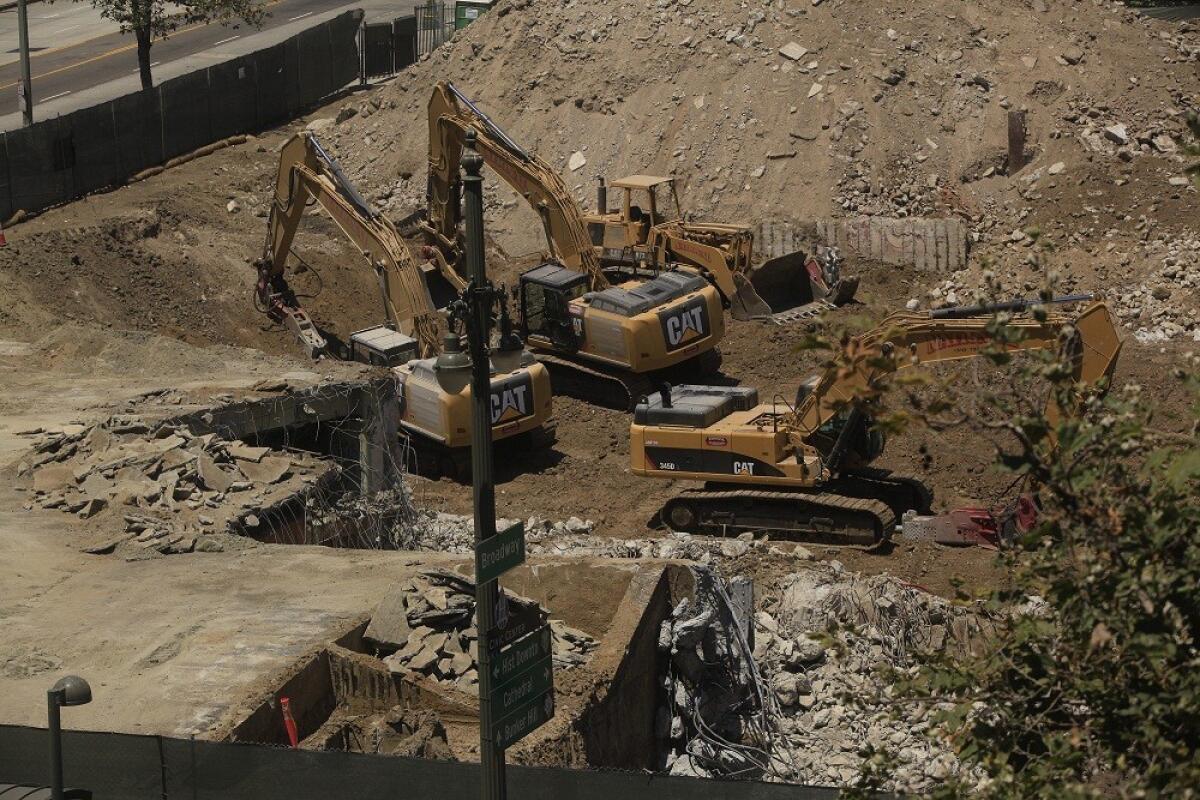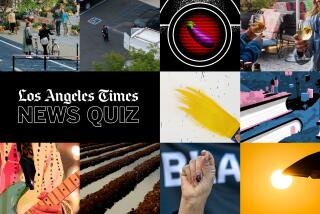Unearthed downtown structure could be old L.A. Times building

Earthmoving equipment has uncovered what might be the basement or foundation of the old L.A. Times building that once stood at the northeast corner of North Broadway and West 1st Street in downtown Los Angeles.
The site is being developed as an extension of Grand Park.
Aerial photos clearly show a structure dug out at the site. Based on a review of archival photos, the footprint of the building lines up with that of two former Times buildings, the earlier of which was blown up by militant unionists.
The possible identity of the ruins was pointed out by alert history buffs. The photos they posted show an odd diagonal slant to the discovered structure that also existed in the former Times building.
City officials were unavailable over the weekend to offer their analysis.
The subterranean structure at the construction site could have been from the second Times building (the one that was blown up), the third, which was later peacefully demolished, or both.
It is also possible that a later building occupied the same footprint.
Whatever the case, the corner -- which has been fenced off for years -- was the site of a sordid and bloody chapter in the paper’s history.
The paper had opened for business in a nearby location as the Los Angeles Daily Times on Dec. 4, 1881, one of a number of newspapers in the bustling town, and not widely regarded as the best -- especially in the view of labor organizers. The paper was virulently anti-union in its editorial policy and practices.
In 1886, at a cost of $50,000, Col. Harrison Gray Otis opened The Times’ second building, a three-story brick and granite structure, at the site now being developed. A more compact six-story adjacent structure housed the printing plant by 1910.
At 1 a.m. on Oct. 1, 1910, a dynamite charge exploded just outside the building and nearby gas lines sparked a disastrous fire.
In the city room, three people were killed or fatally injured, according to an official exhibit in the L.A. Times Globe Lobby. Two died in the telegraph room; 16 in the linotype and composing room. Eight bodies were found at the bottom of a freight elevator shaft.
The newspaper had trouble getting the numbers to add up -- various published accounts over the decades put the death toll between 20 and 30.
The newspaper did not miss a day -- another paper offered the use of its presses.
Had the timing been different, the bombing could easily have claimed future publisher Harry Chandler, who joined the newspaper at 21 in 1885 and married the publisher’s daughter.
Chandler’s desk was close to the work station of a secretary who died instantly in the blast. In 1917, Chandler took over the paper when his father-in-law died of natural causes. He held the publisher’s chair until 1944, and was fully involved in the shaping of Los Angeles as a regional powerhouse.
Two brothers, James and John McNamara, were charged in the explosion. Famed attorney Clarence Darrow was brought in to defend them -- and got into trouble for allegedly trying to bribe a juror.
Darrow eventually persuaded the brothers to plead guilty to avoid the death penalty.
James McNamara took responsibility for The Times bombing; his brother for a factory blast. At the time, militants were involved in a number of factories bombings, trying to cause damage but no loss of life.
The Times bomb may have detonated at the wrong time, and the deadly fire was not anticipated.
The Times built a grander edifice on the same site, with a distinctive castle-like clock tower, that opened two years after the blast and served until the current flagship building opened across the street in 1935.
More to Read
Start your day right
Sign up for Essential California for news, features and recommendations from the L.A. Times and beyond in your inbox six days a week.
You may occasionally receive promotional content from the Los Angeles Times.







